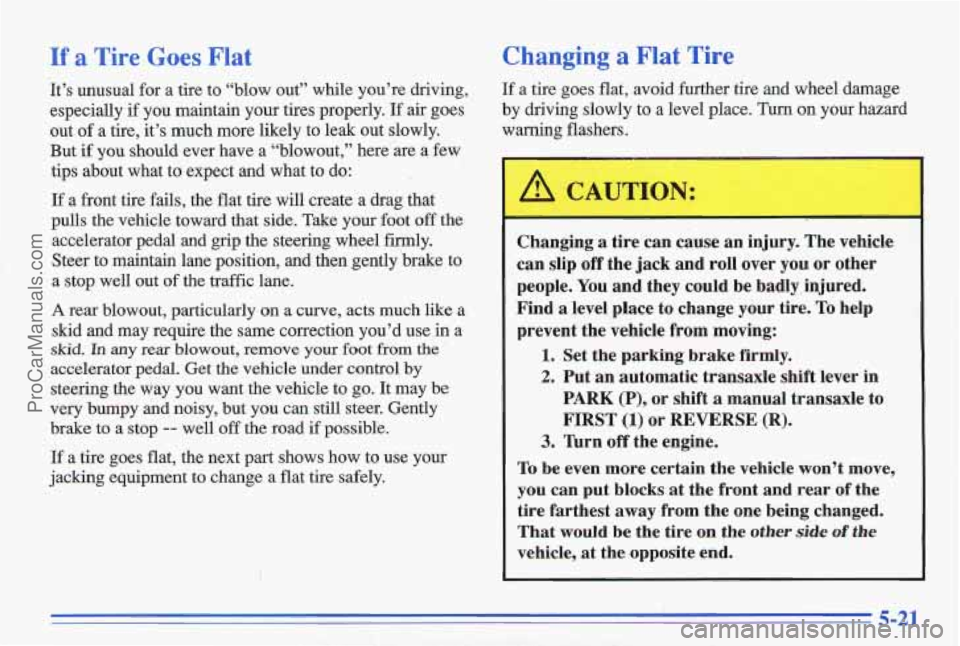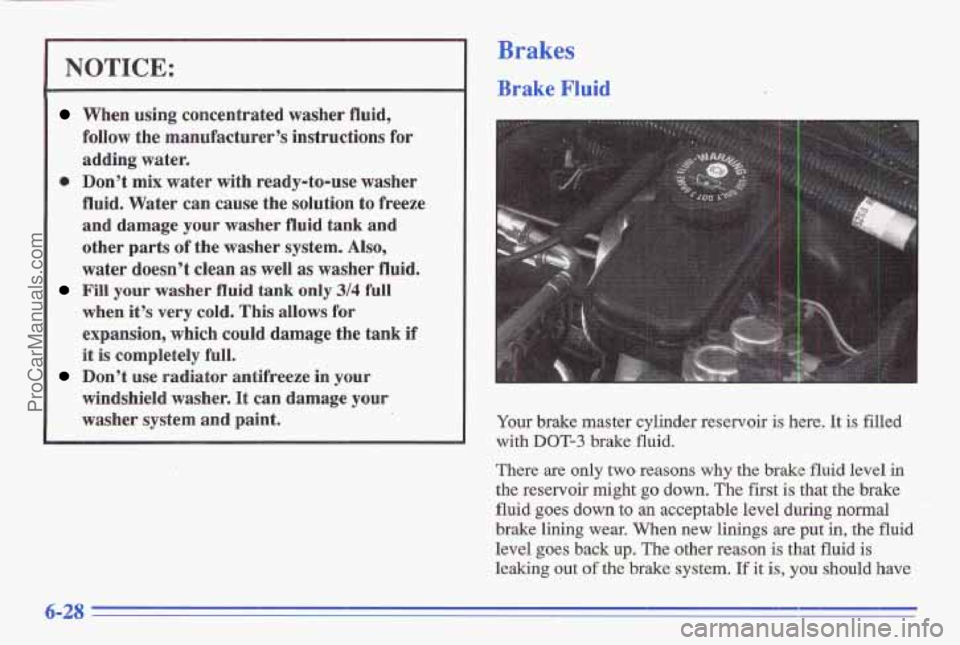Page 211 of 356

If a Tire Goes Flat
It’s unusual for a tire to “blow out” while you’re \
driving,
especially
if you maintain your tires properly. If air goes
out
of a tire, it’s much more likely to leak out slowly.
But
if you should ever have a “blowout,” here are a few
tips about what to expect and what to
do:
If a front tire fails, the flat tire will create a drag that
pulls the vehicle toward that side. Take your foot off the
accelerator pedal and grip the steering wheel firmly.
Steer
to maintain lane position, and then gently ‘brake to
a stop well out
of the traffic lane.
A rear blowout, particularly on a curve, acts much like a
skid and may require the same correction you’d use in a
skid. In my rear blowout, remove your foot from the
accelerator pedal. Get the vehicle under control by
steering the way you want the vehicle to
go. It may be
very bumpy and noisy, but you can
still steer. Gently
brake to a stop
-- well off the road if possible.
If a tire goes flat, the next part shows how to use your
jacking equipment to change a flat tire safely.
Changing a Flat Tire
If a tire goes flat, avoid further tire and wheel damage
by driving slowly
to a level place. Turn on your hazard
warning flashers.
Changing a tire can cause an injury. The vehicle
can slip
off the jack and roll over you or other
people.
You and they could be badly,injured.
Find
a level place to change your tire. To help
prevent the vehicle from moving:
1. Set the parking brake firmly.
2. Put an’automatic transaxle shift lever in
PARK
(P), or shift a manual transaxle to
FIRST (1) or REVERSE (R).
3. lbrn off the engine.
To be even more certain the vehicle won’t move,
you can put blocks at the front and rear of the
tire farthest away from the one being changed.
That would be the tire
on the other side of the
vehicle, at the opposite end.
5-21
ProCarManuals.com
Page 218 of 356

10. Tighten the wheel. nuts
firmly in a criss-cross
sequence, as shown.
-
Incorrect wheel nuts or improperly tightened
wheel nuts can cause the wheel to become loose
and even come
off. This could lead to an accident.
Be sure
to use the correct wheel nuts. If you have
to replace them, be sure
to get new GM original
equipment wheel
nuts.
Stop somewhere as soon as you can.and have the
nuts tightened with
a torque wrench to I00 Ib-ft
(140 N-m).
I NOTICE:
Improperly tightened wheel nuts can lead to
brake pulsation and rotor damage. To avoid
expensive brake repairs, evenly tighten the wheel
nuts in the proper sequence and to the proper
torque specifications.
Don’t itry to put a wheel cover on your compact spare
tire. It won’t fit. Store the wheel cover and plastic
cap nuts in the trunk until you have the flat tire
repaired
or replaced.
... .
NOTICE:
~
Wheel covers won’t, fit on your compact spare.
If you try to put a wheel cover on your compact
spare,
you could damwe the cover or the spare.
~~
5-28
ProCarManuals.com
Page 228 of 356
NOTICE:
If you need a new cap, b'e sure to get the right
type.
Your dealer can get one for you. If you get
the wrong type, it may not fit or have proper
venting, and your fuel tank and emissions system
might be
damaged.
Things that burn can get on hot engine parts and
start
a fire. These include liquids like gasoline,
oil, coolant, brake fluid, windshield washer and
other fluids, and plastic
or rubber. You or others
could b'e burned. Be
careful not to drop or spill
things
that will burn onto a hot engine.
Checking "'lings Under the Hood
r
An electric fan under the hood can start up and
injure
you even when the engine is not running.
Keep hands, clothing and tools away from any
underhood electric
fan.
The following sections tell you how to check fluids,
lubricants and important parts underhood.
TO open the hood, first pull
the handle inside the
vehicle.
ProCarManuals.com
Page 230 of 356
2.4L (CODE T) Engine
When you open the hood, you’ll see:
Brake Fluid Reservoir
B. Engine Oil Fill Cap G. Windshield Washer Fluid Reservoir
C. Engine Oil Dipstick M. Hydraulic Clutch Fluid Reservoir (if so equipped)
D. Automatic Transaxle Dipstick (if equipped) I. Air Cleaner
E. Power Steering Fluid Reservoir J. Battery
6-8
ProCarManuals.com
Page 231 of 356
3.1L (CODE M) Engine
When you open the hood, ou’ll see:
A. Engine Coolant Surge Tank
B. Power Steering Fluid Reservoir
C. Engine Oil Fill Cap
D. Engine Oil Dipstick
E. Automatic Transaxle Fluid Dipstick
6-9
E Brake Fluid Reservoir
G. Windshield Washer Fluid Reservoir
H. Air Cleaner
I. Battery
ProCarManuals.com
Page 240 of 356
Checking the Fluid Level
' Park your vehicle on a level place. Keep the engine
running.
With the parking brake applied, place the shift lever
in
PARK (P). I
With your foot on the brake pedal, move the shift
lever through each
gear range, pausing for about
three seconds in each range. Then, position the shift
lever in PARK (P).
0 Let the engine run at idle for three to five minutes. Then,
without shutting
off the engine, follow these
steps:
1. The automatic transaxle dipstick handle is red. Pull
out the dipstick
and wipe it with a clean rag or paper
towel.
2. hsh it back in all the way, wait three seconds and
then pull it back out again.
6-18
ProCarManuals.com
Page 250 of 356

~~~
~~~~ NOTICE:
~ ~~~~ ~~~~~~~~~
When using concentrated washer fluid,
follow the manufacturer’s instructions for
adding water.
e Don’t mix water with ready-to-use washer’
fluid. Water can cause the solution to freeze
and damage your washer fluid tank and
other parts
of the washer system. Also,
water doesn’t clean
as well as washer fluid.
Fill your washer fluid tank only 3/4 full
when it’s very cold, This allows for
expansion, which could damage the tank
if
it is completely full.
windshield washer.
It can damage your
washer system and paint,
Don’t use radiator antifreeze in your
Brakes
Brake Fluid
Your brake master cylinder reservoir is here. It is filled
with
DOT-3 brake fluid.
There are only two reasons why the brake fluid level in
the reservoir might go down. The first is that the brake
fluid goes down to
an acceptable level during normal
brake lining wear. When new linings
are put in, the fluid
level goes
back up. The other reas’on is that fluid is
leaking out of the brake system, If it is, you should have
6-28
ProCarManuals.com
Page 251 of 356
your brake system fixed, since a leak means that sooner
or later your brakes won’t work well,
or won’t work
at
all.
So, it isn’t a good idea to “top off’ your brake fluid.
Adding brake fluid won’t correct
a leak. If you add fluid
when your linings are worn, then you’ll have too much
fluid when you get new brake linings. You should add
(or remove) brake fluid, as necessary, only when work is
done on the brake hydraulic system.
enough. You or others could be burned, and your
vehicle could be damaged. Add brake fluid only
when work is done on the brake hydraulic
When your brake fluid falls
to a low level, your brake
warning light will come
on.
See “Brake System Warning
Light”
in the Index.
~~
What to Add
When you do need brake fluid, use only DOT-3 brake
fluid
-- such as Delco Supreme 11 @ (GM Part
No. 1052535). Use new brake fluid from a sealed
container only,
and always clean the brake fluid
reservoir cap before removing
it.
ProCarManuals.com